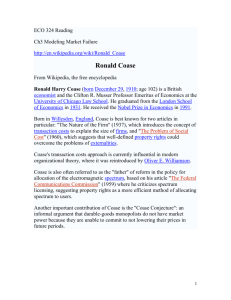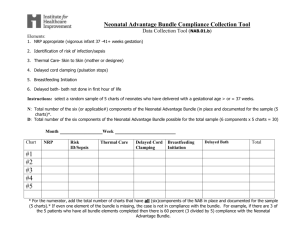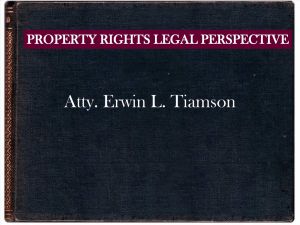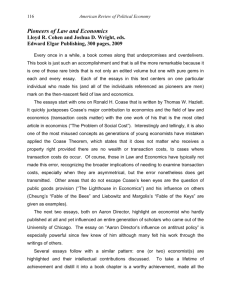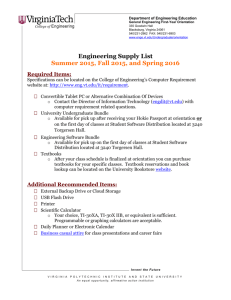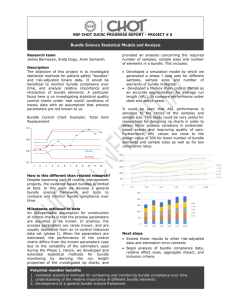Bundle-of-Sticks Notions in Legal and Economic Scholarship
advertisement
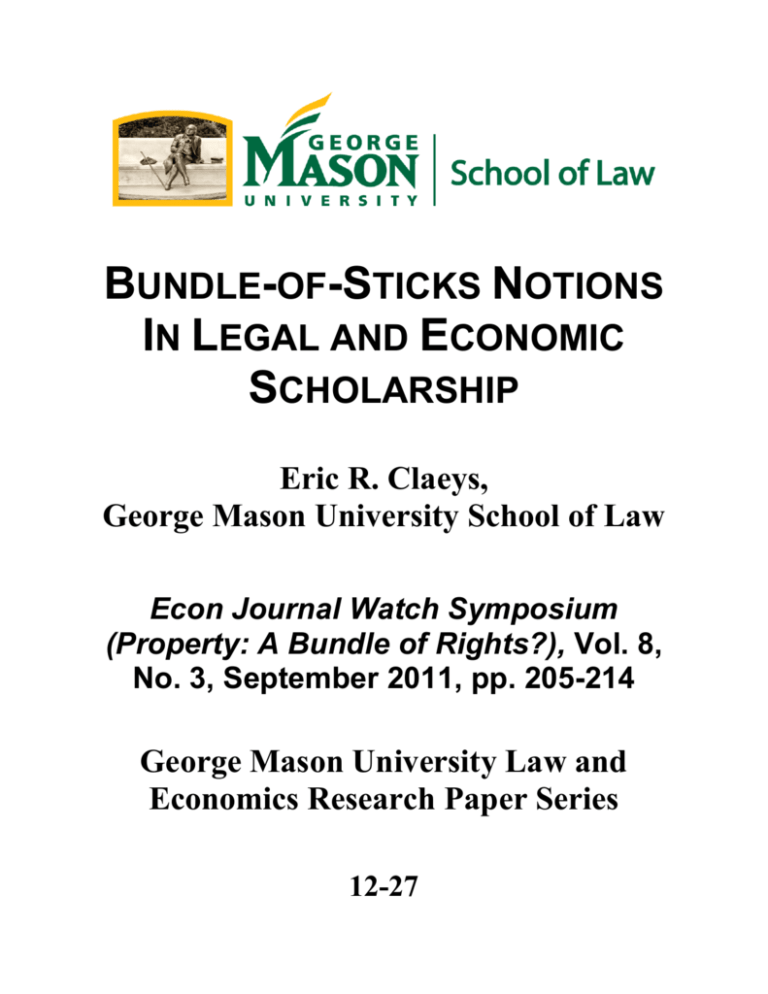
BUNDLE-OF-STICKS NOTIONS IN LEGAL AND ECONOMIC SCHOLARSHIP Eric R. Claeys, George Mason University School of Law Econ Journal Watch Symposium (Property: A Bundle of Rights?), Vol. 8, No. 3, September 2011, pp. 205-214 George Mason University Law and Economics Research Paper Series 12-27 Bundle-of-Sticks Notions in Legal and Economic Scholarship Eric R. Claeys George Mason University Professor of Law Abstract: The phrase “bundle of rights” does not serve as an accurate conceptual definition of property. Nor has that phrase provided a helpful metaphor as used in Ronald Coase’s article “The Problem of Social Cost” (1960) and subsequent legal and economic scholarship. Coase’s usage portrays property rights as a collection of individualized permissions to use an asset, when in sound conceptual usage “property” signifies a domain of authority to decide how to use the asset. The “bundle” metaphor may be understood to state that an owner has a right to deploy his property in any specific manner fairly implied by his general rights of ownership. Although this metaphorical usage is helpful, it remains parasitic on a sound conceptual definition of property. Property is best conceived of as a right securing a normative interest in determining exclusively the use of an asset external to the person of the owner. Keywords: Property, bundle of rights, exclusion, exclusivity, right to exclude, legal realism, law and economics, Wesley Hohfeld, Richard Posner, Harold Demsetz, Armen Alchian, Thomas Merrill, Henry Smith, private law theory, conceptual philosophy. JEL codes: A1, K00, K1 The Prologue to this symposium asks: “Property: A Bundle of Rights?” (Klein and Robinson 2011). If the Prologue asks a strictly conceptual question, certainly not. If it asks whether the “bundle” provides a metaphor helpful for thinking about property, my answer depends on how the metaphor is being used. Let me start with my answer to the conceptual question. It is common for economists and lawyers to describe property as a bundle. Consider this usage by Harold Demsetz: “When a transaction is concluded in the marketplace, two bundles of property rights are exchanged” (1967, 347). In this usage, if G and H have bundles of rights in the fees simple absolute they hold in their lots, G may transfer a smaller bundle to H and all future owners of H’s lot with a right of way and a covenant that G’s lot will only ever be used for single-family residential use. 1 Similarly, H may transfer to G and all future owners of G’s lot reciprocal rights in a corresponding bundle. In another usage, known to legal property scholars as the “HohfeldHonoré vocabulary,” property interests may be restated in terms of correlative normative interests relating to different incidents of ownership. Thus, before transfer, G held normative powers, rights, and privileges in the possession, use, and transfer of his land. After G transferred a right of way, G and his successors in interest held incomplete rights of possession, H and his successors acquired rights and powers to enter consistent with the terms of the right of way, and G and his successors were bound by liabilities and duties not to interfere with the legitimate exercise of the right of way (Munzer 1990, 17-27; Honoré 1961; Hohfeld 1913). These “perspective[s] on property [are] entirely innocuous if regarded merely as an elaboration of the scope of action that ownership provides” (Penner 1996, 741). Speaking strictly and conceptually, however, one does not define a recipe simply by enumerating its ingredients or describing all the different ways in which the final product may be sliced. Similarly, one does not define a conceptual social relation simply by listing all of its constitutive parts or the particular implications that follow from it. If an employer H signed an employment contract with G, H would have a bundle of rights. H’s bundle would include rights to demand performance or expectation damages, to withhold consent if G sought to renegotiate the contract, and to prevent J from knowingly inducing G’s breach. But would any of H’s rights be property rights? Clearly not. Yet Demsetz’s usage cannot explain why not. Honoré’s taxonomy can. The right to demand performance, for instance, has nothing to do with a right to possess, use, or transfer some physical or intangible thing. Yet that taxonomy simply begs the question why rights to possess, use, or transfer a thing are property rights. Honoré’s taxonomy assumes an integrated conception of property without supplying one. 2 So if the bundle is not an adequate conceptual definition of property, is it a helpful metaphor? In some usages, yes. In one usage, particularly common among scholars of economics or law and economics, no. In “The Problem of Social Cost,” Coase (1960) challenged a traditional view, which he attributed to A.C. Pigou, according to which the law could prevent divergence between private and social product by holding polluters responsible for the harmful effects of their pollution. To launch his critique, Coase begins: The traditional approach has tended to obscure the nature of the choice that has to be made. The question is commonly thought of as one in which A inflicts harm on B and what has to be decided is: how should we restrain A? But this is wrong. We are dealing with a problem of a reciprocal nature. To avoid the harm to B would inflict harm on A. The real question that has to be decided is: should A be allowed to harm B or should B be allowed to harm A? (Coase 1960, 2). Coase elaborates how abatement rules, pollution taxes, and other Pigovian solutions may inflict on A economic losses reciprocal to and possibly greater than the pollution losses suffered by B. Coase’s portrait makes sense—from one limited perspective. It makes more sense to scholars of economics or law and economics than it does to lawyers. And even among economics scholars and their fellow-travelers in law, Coase’s perspective makes sense primarily when studying how to maximize welfare from several existing uses of property. “Economists usually take the bundle of property rights as a datum and ask for an explanation of the forces determining the price and the number of units of a good to which these rights attach” (Demsetz 1967, 347; see Coase 1960, 44). In that framework, it makes sense to take A’s and B’s legal rights as givens, inquire how different sources of transaction costs prevent A and B from bargaining to welfare-enhancing alternatives, and then consider how to circumvent those transaction costs. 3 Yet among many economists and law and economics scholars, this parochial perspective has been assumed to portray a deep conceptual truth about property. Coase bears some responsibility for encouraging this assumption. In “Social Cost,” Coase said offhandedly that although “[w]e may speak of a person owning land and using it as a factor of production, … what the land-owner in fact possesses is the right to carry out a circumscribed list of actions” (Coase 1960, 44; see Merrill and Smith 2001, 367). As Merrill and Smith have explained, many scholars in economics or law and economics subsequently assumed that Coase had proven that “[p]roperty is the collectively imposed allocation of use rights with respect to any particular resource” (2001, 379). Such scholars have also assumed that the focus of law and economics property scholarship is and should be “to elaborate how courts should go about framing collective solutions to establish use rights to establish efficiency” (ibid.). Consider how Posner uses a train-sparks dispute, an example popularized by “Social Cost,” to illustrate how law and economics regulates “incompatible uses”: Truly exclusive (absolute, unqualified) property rights would be a contradiction in terms. If a railroad is to enjoy the exclusive use of its right-of-way, it must be permitted to emit engine sparks without legal limitation; the value of its property will be impaired otherwise. But the value of adjacent farmland will be reduced because of the fire hazard from the sparks. Is the emission of sparks an incident of the railroad’s property right (that is, part of its bundle of rights) or an invasion of the farmer’s property right (or bundle)? (Posner 2011, 63) In Posner’s portrait, there is no tight conceptual connection between railroad A’s privilege to emit sparks and A’s property. The same goes for B’s right to exclude sparks and B’s property. Each has “property” writ large in a list of individual permissions to use his trains or land (respectively) at different levels determined to be socially valuable by public officials. A court or regulator should “approximate the [economically] optimum definition of property rights, [for] these approximations may guide resource use more efficiently than would an economically random assignment of rights” (ibid., 65). This is the view others and I have called and criticized 4 as an “ad hoc bundle conception.” This conception recasts property as a list of permissions— individualized uses that public officials deem it socially desirable for owners to have on case-bycase evaluation (Claeys 2009, 623-24; see Merrill and Smith forthcoming, 2). Posner (and Coase as channeled through Posner) present “property” in a manner alien to social practice and the private law because they recast the “rights” in property. In social practice and private law, “rights” refer not to single-use permissions but to domains of freedom or decisional authority. Such domains are structured to give many different individuals authority to decide—simultaneously, each right-holder for himself—how to use a given resource or aspect of his personality for his own individual benefit. When they neglect or reject this understanding of rights, Posner and the Posnerian Coase invert the conceptual structure of “harm” and “causation.” The statement “[t]o avoid the harm to B would inflict harm on A” makes sense if A and B’s “rights” refer to incompatible and reciprocal permissions to engage in two particular conflicting uses. In practice, however, “causation” and “harm” fit social perceptions about who is threatening whose legitimate decisional authority. Assume that B injures A while successfully repelling A’s attempt to hold him up. In Coase’s framework, the injuries B inflicts on A are reciprocal negative externalities on A’s desire for money from B. In common sense, this portrait is grotesque. With appropriate adjustments, the same relations apply to property disputes. Even if B planted crops where A’s cinders could burn them, if A was the only party who invaded someone else’s rights, A is the sole “cause” of recognized social “harm.” (See Claeys 2010, 1393-94, 1405-14; Merrill and Smith 2001, 391-97). So if Posner and the Posnerian Coase conceive of property and rights wrongly, how are these institutions conceived of rightly? I prefer to define “property” as a right securing an interest in determining exclusively the use of an asset external to the owner’s person (Claeys 5 2011, 17-28). Because this definition focuses on external assets, it explains why an employment contract does not give rise to a bundle of property rights. The rights that accrue in such a contract arise by virtue of mutual enforceable promises—not by virtue of an owner’s interest in setting priorities for using a lot of land, an animal, a car, or an invention. This definition also incorporates the idea of legitimate decisional authority lacking in Posner and the Posnerian Coase’s conception of property. For the same reason, this definition answers one of the Prologue’s questions: whether “property” consists of “a finite list of definite uses or rights.” No. Physical-invasion tests illustrate the idea of decisional authority vividly. These rules require public decision makers to conduct only simple and apolitical inquiries: Did train A invade farmer B’s ground or airspace? These boundary rules prevent A from emitting sparks or engaging in other uses that invade B’s land. More subtly, they limit the discretion of public regulators to administer B’s land. By focusing the inquiries of regulators on apolitical questions about invasions, boundary rules bar them from balancing B’s intended uses against A’s in all but close cases. In doing so, such rules establish and conserve to both A and B parallel discretion to decide how best to use their rights of way or lands. B reserves the rights to enjoy a residential home, to farm, to operate a store, and conduct many other land uses consistent with his correlative responsibilities not to trespass, pollute on, or otherwise interfere unreasonably with his neighbors’ land uses. Yet these rights do not give B property in a finite list of uses; they are all specific implications of his general and undelineated property in determining exclusively the use of his land. This definition of “property,” however, does not make property rigid, unchangeable, or immune from any qualification. The Prologue asks whether fence-out rules or rights to roam count as property rights or invasions of owners’ property rights. One may ask similar questions 6 about rights of access for fishing, hunting, or stick-gathering. Such rules and rights confer property rights on non-owners. Even though the non-owners’ rights are not as broad as fees simple absolute, they are rights, grounded in the non-owners’ interests in using and engaging with the land. In addition, conceptually, such property rights are not diminutions or violations of owner property rights. When law and social practice institute rights of use or access for nonowners, they limit the owners’ property to conform to expectations implied in the conceptual meaning of “property.” When a political community entitles non-owners to claim use or access rights on the land of others, it recognizes the interests of ranchers, roamers, fishers, hunters, or stick-gatherers in “using” the land to conduct each of their particular activities. Of course, the law endows the owners with broad rights to exclusive control and possession over their land in all circumstances not covered by those use or access rights. In doing so, however, the law reflects a normative judgment, by the same community, that land owners deserve domains of “use” much broader than the activity-specific “uses” that go with use or access rights. When it entitles owners to all residual rights to control access to or use of their land, the political community endows them with a right to choose to which activities the land will be deployed most intensively and regularly—that is, to determine generally how the land will be used. Indeed, in the right social and economic conditions, it would be consistent with my definition for a political community to declare land not to be owned privately at all. For example, if a tribe of aboriginal natives does not farm and instead hunts, it may institute private property in captured animals but leave land in a commons to which all members of the tribe have equal access. Such ownership makes the land most accessible for use by all for the most common intended uses, tracking and hunting. However, if the community begins to trade animal furs for objects of value, it may reconfigure land rights to institute private property in land. That 7 reconfiguration lets the members of the community shift to animal husbandry and fur production if most or all find land more useful for those purposes (see Demsetz 1967, 351-52). My definition does make it more difficult to conduct some kinds of normative policymaking—policy-making at the level of granularity that Posner and fellow-travelers prefer. As Coase himself anticipated, Posner’s portrait of the economics of sparks “would require a detailed knowledge of individual preferences” (1960, 41). It is difficult or even impossible “to imagine how the data needed for such a … system could be assembled” (ibid.). While “Social Cost” legitimizes Posnerian law and economics in some respects, other aspects of Coasean comparative institutional analysis encourage strong skepticism about the Posnerian approach (Merrill and Smith forthcoming). I am grateful to the authors of the Prologue for quoting several articles in which I have elaborated the claims and criticisms recounted here (see Klein and Robinson 2011.) However, some readers might assume from those quotations that I am skeptical of all usages of the term “bundle.” I am not. Alchian (2008) has defined property as “the exclusive authority to determine how a resource is used,” and I am fully satisfied with his definition. As critical as I am of Posner, I give him partial credit for defining property rights as “rights to the exclusive use of valuable resources.” Posner gets only partial credit because he applies this definition ad hoc. He treats property rights in terms of exclusive use when he focuses on “dynamic” issues relating to investment. He then flips to the list-of-uses approach in “static” disputes (e.g., disputes over sparks), where he assumes he can fine-tune a few parties’ conflicting uses without disturbing any party’s long-term incentives to invest (Posner 2011, 39-40). Nor do I mean to suggest that all definitions of property by lawyers are well-conceived. The tendencies I am criticizing in Posner and Coase were first proposed by Legal Realist 8 scholars who deconstructed property in the 1920s (see Merrill and Smith 2001, 364-366). Thanks to the Realists, many legal scholars who do not identify with Coase or Posner assume that the concept of property has “disintegrated” in contemporary practice (Grey 1980). And the contemporary U.S. Supreme Court relies on logic as deconstructionist as Posner’s to blur the extent to which state or local land-use, rent-control, or environmental regulations extinguish use rights classified at common law as property (see Claeys 2004, 203-20; Penn Central Transportation Co. v. New York City 1978). Nor should my definition of property be confused with definitions holding that “property at its core entails the right to exclude others from a thing” (Merrill and Smith 2007, v; see Penner 1997, 71). There are subtle but important differences between a right to exclude and what I prefer to call a right of exclusive use-determination. In extremely telescoped form, exclusion is a consequence of use and not the other way around. If A has a right of access to fish, B has a profit to pick apples, and C retains all other general control over and use of a lot of land, a lawyer can predict when each may exclude the others or strangers from interfering with their uses. By contrast, if the lawyer knows only that A, B, and C all have rights to exclude, she will not be able to predict whether A has a fee simple, a right of access, or so forth. Nor will she be able to predict in what circumstances, or against which parties, A, B, or C will be able to assert exclusionary power. Readers who are interested in further elaboration should consult Adam Mossoff’s contribution to this Symposium (Mossoff 2011; see also Mossoff 2003, 377-390; Katz 2008; Claeys 2009; and Claeys 2011). The Prologue suggests that exclusion reflected the dominant understanding of property in Western law until the early 20th century and that the bundle notion correlated with the rise of collectivist theories of government administration in the U.S. and the West generally in the 9 twentieth century (Klein and Robinson 2011, xx-xx). Although I have assumed this suggestion in one article (Claeys 2006, 447-451), I have since disavowed it because I have come to see that the history is more complicated (Claeys 2009, 622-623 & n.24). Neither Roman law nor preEnlightenment political theory justified a view of property as an integrated concept nearly to the extent as did Pufendorf, Grotius, Locke, or their successors (on whom, see Mossoff 2003). Indeed, one might call the Roman law correlating to what we now know as property to consist of a bundle of rights of use, enjoyment, and consumption (see Nicholas 1962, 98-157). Separately, the earliest American usage of the “bundle” of which I am aware used the term as a trump against government confiscation. This usage occurred in a treatise arguing that the government took property whenever it took any stick out of an owner’s bundle (Lewis 1888, 45). This is the usage Demsetz assumes when he speaks of “two bundles of property rights [being] exchanged” (1967, 347). I have no problem with this usage. In social practice and private law, this usage elaborates how a general right of use-determination implies many specific rights to use, transfer, set conditions on entry, and so forth. Even though contemporary eminent domain law uses an ad hoc bundle conception to obscure the extent to which public regulations interfere with property, Lewis’s usage helps clarify the real impact of those regulations. To repeat, however, this usage is derivative. Assume A owns land in fee simple absolute and seeks to sell it to B with a substantive restriction that the land never be alienated again. If A’s property rights consist of a bundle, is the right to transfer in A’s bundle? Surely yes. Does the bundle then also include a right to impose a total restriction on future alienation as a condition on such transfer? This question is harder to answer. Conceptual theory can help frame the law’s answer to the question, but at the end of the day normative considerations must settle that answer. Doctrinally, a total restraint on alienation is void. Normatively, that rule seems 10 right. Conceptually, however, bundle metaphors do not help explain why. Those metaphors only suggest that the right to restrain alienation might belong or not belong in the property bundle. Yet they do not limit or identify the normative questions that the concept “property” will prompt a public official to ask before deciding whether that right belongs in the bundle. By contrast, the conception I have proposed here does clarify and focus the relevant normative questions. If property consists of a right securing an interest in determining exclusively the use of a thing, then fee simple ownership should imply a right to impose total future-alienation restrictions only if it seems practically certain that the inclusion of this lesser right will enhance all present and potential future owners’ interests in determining their lots’ uses. Yet the right to impose permanent restraints on future alienation seems likely to choke the future use of lots burdened. If land-use patterns changed significantly over a century, such restrictions would almost certainly prevent the highest-valuing new users from acquiring the land and conforming it to changing land-use trends. That possibility provides a reason not to include the right to impose permanent alienation restrictions in the bundle. And this example illustrates my basic point: One cannot know which sticks belong in the property bundle without knowing how that bundle needs to be configured to enhance owners’ concurrent interests in determining exclusively the uses of their properties. REFERENCES Alchian, Armen A. 2008. Property Rights. In The Concise Encyclopedia of Economics, ed. David R. Henderson. Online: www.econlib.org/library/Enc/PropertyRights.html (cited: August 23, 2011). Claeys, Eric R. 2004. Takings and Private Property on the Rehnquist Court. Northwestern University Law Review 99(1): 187-230. 11 Claeys, Eric R. 2006. Takings: An Appreciative Retrospective. William and Mary Bill of Rights Journal 15(2): 439-455. Claeys, Eric R. 2009. Property 101: Is Property a Thing or a Bundle? Seattle University Law Review 32(3): 617-650. Claeys, Eric R. 2010. Jefferson Meets Coase: Land-Use Torts, Law and Economics, and Natural Property Rights. Notre Dame Law Review 85(4): 1379-1446. Claeys, Eric R. 2011. Exclusion and Exclusivity in Gridlock. Arizona Law Review 53(1): 9-49. Coase, Ronald H. 1960. The Problem of Social Cost. Journal of Law and Economics 3: 1-44. Demsetz, Harold. 1967. Toward a Theory of Property Rights. American Economic Review 57(2): 347-359. Grey, Thomas C. 1980. The Disintegration of Property. In Property: NOMOS XXII, eds. J. Roland Pennock and John W. Chapman. New York: New York University Press, 69-86. Hohfeld, Wesley N. 1913. Some Fundamental Legal Conceptions in Legal Reasoning. Yale Law Journal 23(1): 16-59. Honoré, Anthony M. 1961. Ownership. In Oxford Essays in Jurisprudence, ed. A.G. Guest. Oxford: Clarendon Press, 107-147. Katz, Larissa. 2008. Exclusion and Exclusivity in Property Law. University of Toronto Law Journal 58(3): 275-315. Klein, Daniel B., and John Robinson. 2011. Property: A Bundle of Rights? Prologue to the Property Symposium. Econ Journal Watch 8(3): xx-xx. Link Lewis, John. 1888. A Treatise on the Law of Eminent Domain. Chicago: Callaghan. Merrill, Thomas W., and Henry E. Smith. 2001. What Happened to Property in Law and Economics? Yale Law Journal 111(2): 357-398. Merrill, Thomas W., and Henry E. Smith. 2007. Property: Principles and Policies. New York: Foundation Press. Merrill, Thomas W. and Henry E. Smith. Forthcoming. Making Coasean Property More Coasean. Journal of Law & Economics. Link Mossoff, Adam. 2003. What Is Property? Putting the Pieces Back Together. Arizona Law Review 45(2): 371-443. 12 Mossoff, Adam. 2011. The False Promise of the Right to Exclude. Econ Journal Watch 8(3): xxx-xxx. Link Munzer, Stephen R. 1990. A Theory of Property. New York: Cambridge University Press. Nicholas, Barry. 1962. An Introduction to Roman Law. Oxford: Clarendon Press. Penner, James E. 1996. The “Bundle of Rights” Picture of Property. UCLA Law Review 43(3): 711-820. Penner, James E. 1997. The Idea of Property in Law. Oxford: Clarendon Press. Posner, Richard A. 2011. Economic Analysis of Law. 8th ed. New York: Aspen Publishers. Case Cited Penn Central Transportation Co. v. New York City, 438 U.S. 104 (1978). Eric Claeys is Professor of Law at George Mason University. He has written extensively on the influence of Lockean natural-rights theory on American property and tort law. 13


